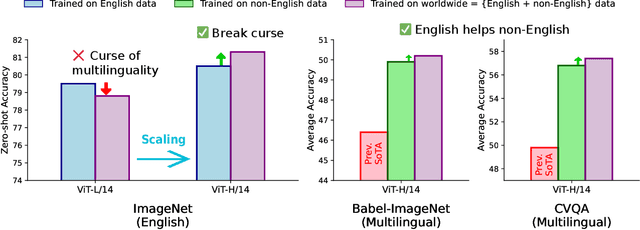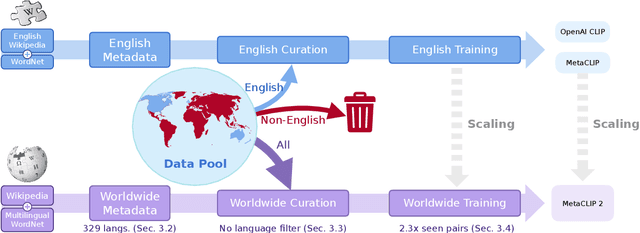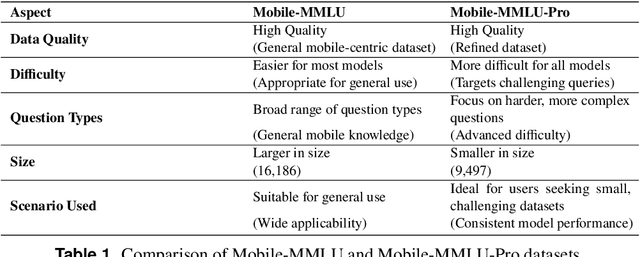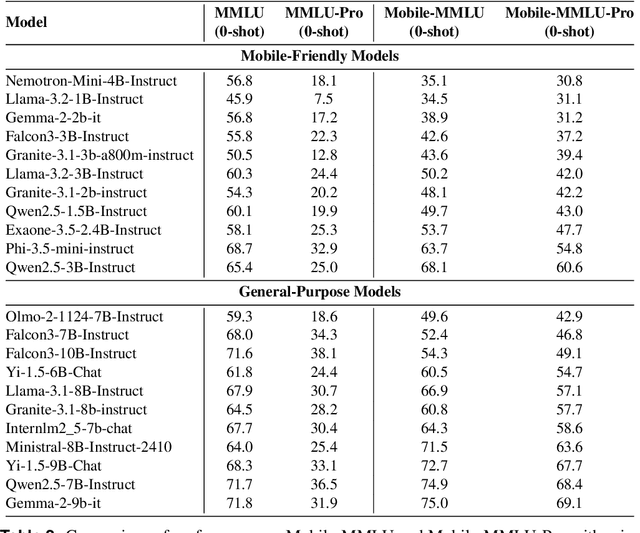Zhuang Liu
MetaCLIP 2: A Worldwide Scaling Recipe
Jul 29, 2025



Abstract:Contrastive Language-Image Pretraining (CLIP) is a popular foundation model, supporting from zero-shot classification, retrieval to encoders for multimodal large language models (MLLMs). Although CLIP is successfully trained on billion-scale image-text pairs from the English world, scaling CLIP's training further to learning from the worldwide web data is still challenging: (1) no curation method is available to handle data points from non-English world; (2) the English performance from existing multilingual CLIP is worse than its English-only counterpart, i.e., "curse of multilinguality" that is common in LLMs. Here, we present MetaCLIP 2, the first recipe training CLIP from scratch on worldwide web-scale image-text pairs. To generalize our findings, we conduct rigorous ablations with minimal changes that are necessary to address the above challenges and present a recipe enabling mutual benefits from English and non-English world data. In zero-shot ImageNet classification, MetaCLIP 2 ViT-H/14 surpasses its English-only counterpart by 0.8% and mSigLIP by 0.7%, and surprisingly sets new state-of-the-art without system-level confounding factors (e.g., translation, bespoke architecture changes) on multilingual benchmarks, such as CVQA with 57.4%, Babel-ImageNet with 50.2% and XM3600 with 64.3% on image-to-text retrieval.
Generative Modeling of Weights: Generalization or Memorization?
Jun 09, 2025Abstract:Generative models, with their success in image and video generation, have recently been explored for synthesizing effective neural network weights. These approaches take trained neural network checkpoints as training data, and aim to generate high-performing neural network weights during inference. In this work, we examine four representative methods on their ability to generate novel model weights, i.e., weights that are different from the checkpoints seen during training. Surprisingly, we find that these methods synthesize weights largely by memorization: they produce either replicas, or at best simple interpolations, of the training checkpoints. Current methods fail to outperform simple baselines, such as adding noise to the weights or taking a simple weight ensemble, in obtaining different and simultaneously high-performing models. We further show that this memorization cannot be effectively mitigated by modifying modeling factors commonly associated with memorization in image diffusion models, or applying data augmentations. Our findings provide a realistic assessment of what types of data current generative models can model, and highlight the need for more careful evaluation of generative models in new domains. Our code is available at https://github.com/boyazeng/weight_memorization.
Scaling Language-Free Visual Representation Learning
Apr 01, 2025



Abstract:Visual Self-Supervised Learning (SSL) currently underperforms Contrastive Language-Image Pretraining (CLIP) in multimodal settings such as Visual Question Answering (VQA). This multimodal gap is often attributed to the semantics introduced by language supervision, even though visual SSL and CLIP models are often trained on different data. In this work, we ask the question: "Do visual self-supervised approaches lag behind CLIP due to the lack of language supervision, or differences in the training data?" We study this question by training both visual SSL and CLIP models on the same MetaCLIP data, and leveraging VQA as a diverse testbed for vision encoders. In this controlled setup, visual SSL models scale better than CLIP models in terms of data and model capacity, and visual SSL performance does not saturate even after scaling up to 7B parameters. Consequently, we observe visual SSL methods achieve CLIP-level performance on a wide range of VQA and classic vision benchmarks. These findings demonstrate that pure visual SSL can match language-supervised visual pretraining at scale, opening new opportunities for vision-centric representation learning.
Mobile-MMLU: A Mobile Intelligence Language Understanding Benchmark
Mar 26, 2025



Abstract:Rapid advancements in large language models (LLMs) have increased interest in deploying them on mobile devices for on-device AI applications. Mobile users interact differently with LLMs compared to desktop users, creating unique expectations and data biases. Current benchmark datasets primarily target at server and desktop environments, and there is a notable lack of extensive datasets specifically designed for mobile contexts. Additionally, mobile devices face strict limitations in storage and computing resources, constraining model size and capabilities, thus requiring optimized efficiency and prioritized knowledge. To address these challenges, we introduce Mobile-MMLU, a large-scale benchmark dataset tailored for mobile intelligence. It consists of 16,186 questions across 80 mobile-related fields, designed to evaluate LLM performance in realistic mobile scenarios. A challenging subset, Mobile-MMLU-Pro, provides advanced evaluation similar in size to MMLU-Pro but significantly more difficult than our standard full set. Both benchmarks use multiple-choice, order-invariant questions focused on practical mobile interactions, such as recipe suggestions, travel planning, and essential daily tasks. The dataset emphasizes critical mobile-specific metrics like inference latency, energy consumption, memory usage, and response quality, offering comprehensive insights into model performance under mobile constraints. Moreover, it prioritizes privacy and adaptability, assessing models' ability to perform on-device processing, maintain user privacy, and adapt to personalized usage patterns. Mobile-MMLU family offers a standardized framework for developing and comparing mobile-optimized LLMs, enabling advancements in productivity and decision-making within mobile computing environments. Our code and data are available at: https://github.com/VILA-Lab/Mobile-MMLU.
Transformers without Normalization
Mar 13, 2025Abstract:Normalization layers are ubiquitous in modern neural networks and have long been considered essential. This work demonstrates that Transformers without normalization can achieve the same or better performance using a remarkably simple technique. We introduce Dynamic Tanh (DyT), an element-wise operation $DyT($x$) = \tanh(\alpha $x$)$, as a drop-in replacement for normalization layers in Transformers. DyT is inspired by the observation that layer normalization in Transformers often produces tanh-like, $S$-shaped input-output mappings. By incorporating DyT, Transformers without normalization can match or exceed the performance of their normalized counterparts, mostly without hyperparameter tuning. We validate the effectiveness of Transformers with DyT across diverse settings, ranging from recognition to generation, supervised to self-supervised learning, and computer vision to language models. These findings challenge the conventional understanding that normalization layers are indispensable in modern neural networks, and offer new insights into their role in deep networks.
Idiosyncrasies in Large Language Models
Feb 17, 2025Abstract:In this work, we unveil and study idiosyncrasies in Large Language Models (LLMs) -- unique patterns in their outputs that can be used to distinguish the models. To do so, we consider a simple classification task: given a particular text output, the objective is to predict the source LLM that generates the text. We evaluate this synthetic task across various groups of LLMs and find that simply fine-tuning existing text embedding models on LLM-generated texts yields excellent classification accuracy. Notably, we achieve 97.1% accuracy on held-out validation data in the five-way classification problem involving ChatGPT, Claude, Grok, Gemini, and DeepSeek. Our further investigation reveals that these idiosyncrasies are rooted in word-level distributions. These patterns persist even when the texts are rewritten, translated, or summarized by an external LLM, suggesting that they are also encoded in the semantic content. Additionally, we leverage LLM as judges to generate detailed, open-ended descriptions of each model's idiosyncrasies. Finally, we discuss the broader implications of our findings, particularly for training on synthetic data and inferring model similarity. Code is available at https://github.com/locuslab/llm-idiosyncrasies.
MetaMorph: Multimodal Understanding and Generation via Instruction Tuning
Dec 18, 2024Abstract:In this work, we propose Visual-Predictive Instruction Tuning (VPiT) - a simple and effective extension to visual instruction tuning that enables a pretrained LLM to quickly morph into an unified autoregressive model capable of generating both text and visual tokens. VPiT teaches an LLM to predict discrete text tokens and continuous visual tokens from any input sequence of image and text data curated in an instruction-following format. Our empirical investigation reveals several intriguing properties of VPiT: (1) visual generation ability emerges as a natural byproduct of improved visual understanding, and can be unlocked efficiently with a small amount of generation data; (2) while we find understanding and generation to be mutually beneficial, understanding data contributes to both capabilities more effectively than generation data. Building upon these findings, we train our MetaMorph model and achieve competitive performance on both visual understanding and generation. In visual generation, MetaMorph can leverage the world knowledge and reasoning abilities gained from LLM pretraining, and overcome common failure modes exhibited by other generation models. Our results suggest that LLMs may have strong "prior" vision capabilities that can be efficiently adapted to both visual understanding and generation with a relatively simple instruction tuning process.
Understanding Bias in Large-Scale Visual Datasets
Dec 02, 2024Abstract:A recent study has shown that large-scale visual datasets are very biased: they can be easily classified by modern neural networks. However, the concrete forms of bias among these datasets remain unclear. In this study, we propose a framework to identify the unique visual attributes distinguishing these datasets. Our approach applies various transformations to extract semantic, structural, boundary, color, and frequency information from datasets, and assess how much each type of information reflects their bias. We further decompose their semantic bias with object-level analysis, and leverage natural language methods to generate detailed, open-ended descriptions of each dataset's characteristics. Our work aims to help researchers understand the bias in existing large-scale pre-training datasets, and build more diverse and representative ones in the future. Our project page and code are available at http://boyazeng.github.io/understand_bias .
LongVU: Spatiotemporal Adaptive Compression for Long Video-Language Understanding
Oct 22, 2024



Abstract:Multimodal Large Language Models (MLLMs) have shown promising progress in understanding and analyzing video content. However, processing long videos remains a significant challenge constrained by LLM's context size. To address this limitation, we propose LongVU, a spatiotemporal adaptive compression mechanism thats reduces the number of video tokens while preserving visual details of long videos. Our idea is based on leveraging cross-modal query and inter-frame dependencies to adaptively reduce temporal and spatial redundancy in videos. Specifically, we leverage DINOv2 features to remove redundant frames that exhibit high similarity. Then we utilize text-guided cross-modal query for selective frame feature reduction. Further, we perform spatial token reduction across frames based on their temporal dependencies. Our adaptive compression strategy effectively processes a large number of frames with little visual information loss within given context length. Our LongVU consistently surpass existing methods across a variety of video understanding benchmarks, especially on hour-long video understanding tasks such as VideoMME and MLVU. Given a light-weight LLM, our LongVU also scales effectively into a smaller size with state-of-the-art video understanding performance.
Amphista: Accelerate LLM Inference with Bi-directional Multiple Drafting Heads in a Non-autoregressive Style
Jun 19, 2024



Abstract:Large Language Models (LLMs) inherently use autoregressive decoding, which lacks parallelism in inference and results in significantly slow inference speeds, especially when hardware parallel accelerators and memory bandwidth are not fully utilized. In this work, we propose Amphista, a speculative decoding algorithm that adheres to a non-autoregressive decoding paradigm. Owing to the increased parallelism, our method demonstrates higher efficiency in inference compared to autoregressive methods. Specifically, Amphista models an Auto-embedding Block capable of parallel inference, incorporating bi-directional attention to enable interaction between different drafting heads. Additionally, Amphista implements Staged Adaptation Layers to facilitate the transition of semantic information from the base model's autoregressive inference to the drafting heads' non-autoregressive speculation, thereby achieving paradigm transformation and feature fusion. We conduct a series of experiments on a suite of Vicuna models using MT-Bench and Spec-Bench. For the Vicuna 33B model, Amphista achieves up to 2.75$\times$ and 1.40$\times$ wall-clock acceleration compared to vanilla autoregressive decoding and Medusa, respectively, while preserving lossless generation quality.
 Add to Chrome
Add to Chrome Add to Firefox
Add to Firefox Add to Edge
Add to Edge